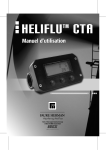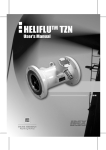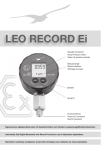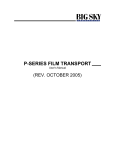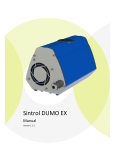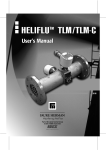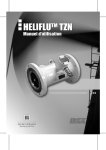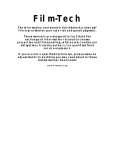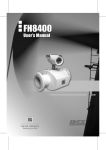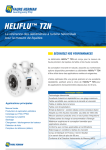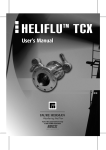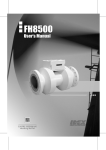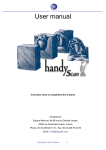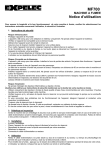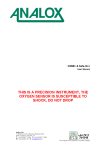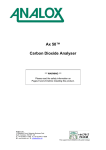Download User`s manual - Faure Herman
Transcript
TM HELIFLU 1 CTA Faure Herman Route de Bonnétable BP 20154 72406 La Ferté Bernard Cedex Tél: (33 2) 43 60 28 60 Fax: (33 2) 43 60 28 70 E-mail: [email protected] Faure Herman Meter Inc Houston TX. 77040 (U.S.A.) Phone: + 1713 623 0808 Fax: + 1713 623 2332 E-mail: [email protected] 2 TEC 04.09.02 Revision index G 26/06/2007 General contents Note: The detailed contents are inserted on the end of manual Recommendations ATEX 5 Chapter 1: Introduction 13 Chapter 2: Description 17 Chapter 3: Equipment reception and storage 23 Chapter 4: Operation 25 Chapter 5: Installation conditions 29 Chapter 6: Commissioning 31 Chapter 7: Servicing 33 Chapter 8: Dysfunctions 35 Chapter 9: Analysis of pressure related risks 37 Appendix 1 39 3 CTA 4 TEC 04.09.02 Revision index G 26/06/2007 Recommendations ATEX 5 CTA 6 TEC 04.09.02 Revision index G 26/06/2007 Recommendations ATEX CTA family 7 CTA This equipment is an assembly of a non electrical part and an electrical part which are both ATEX certified relating to the design and construction of equipment intended for use in potentially explosive atmospheres (94/9/CE directive). General: For safety utilization, be sure that you use this equipment in totally compliance with its ATEX certificate and nameplates indications, and respect the installation, maintenance and user's manuals of the equipment and its different parts. Marking for the assembly: Non electrical Part + Electrical Part This equipment is suitable in hazardous area complying with its protection system and the indications specified on its nameplates. Electrical power must be "OFF" before and during Installation and Maintenance. This equipment shall be handled with the greatest care and mounted in a location to avoid possible shocks. Installation and Maintenance operation shall be done by means of suitable tools. Never use a hammer, impact wrench or any tools which can make sparks or damage the equipment protection system. 8 TEC 04.09.02 Revision index G 26/06/2007 Recommendations ATEX CTA family If this equipment is supposed to be connected to other devices, verify that the protection systems are compatible. Installation, maintenance and repairs of this equipment shall be carried out by suitably trained personnel and the spare parts shall be approved by FAURE HERMAN. No operations or repairs which can affect the protective system could be done on this equipment without FAURE HERMAN agreement. For specifically installation and maintenance advices, contact FAURE HERMAN After Sales Department FAURE HERMAN Route de Bonnétable – 72400 LA FERTE BERNARD Tel : +33 (0)2 43 60 28 80 Fax: +33 (0)2 43 60 28 70 E-mail: [email protected] For any contacts, Don’t forget to give us your equipment serial number. Unit protective system: The Unit certification is defined under the certificate number LCIE 05 ATEX 6059X. This equipment is manufactured with a construction protective system for the non electrical part and an intrinsically safe protective system for the electrical part. This equipment as a unit can be used in an II 2 G potentially explosive atmospheres (gas on surface in a zone 1) with a IIB gas group. 9 CTA Marking of the equipment as a unit shall include the following ATEX indications: Marking FAURE HERMAN BP20154 - 72406 La Ferté Bernard Made in France Equipment : S/N… Year CE LCIE 05 ATEX 6059 X II 1/2 G EEx ia IIB T4 c T6 Description Company name Company address Model Serial number Manufacturing year CE Logo ATEX agreement number ATEX marking Equipment category Protection type and Temperature classification (electrical part) Protection type and Temperature classification (Non electrical part) The equipment can also carry the usual marking required by the manufacturing standards applying to such equipments. For a safety utilization of the equipment, fluid temperature must be contained between -40°C and +60°C. The ambient temperature must be contained between -40°C and +60°C. The temperature classification of the unit is T4. Non electrical part protective system: This equipment is manufactured with a construction protective system in accordance with the European standards NF EN 13463-1 and NF EN 13463-5. 10 TEC 04.09.02 Revision index G 26/06/2007 Recommendations ATEX CTA family Electrical part protective system: The electrical part certification is defined under the certificate number INERIS 04 ATEX 0012X. The electrical part of this equipment is an autonomous counting electronics with an intrinsically safe protective system ("ia") in accordance with the European standards NF 60079-0, NF 60079-11. This autonomous electronic is supplied with a lithium cell of a maximum voltage of 3,6 Volts. This cell must be as following: Manufacturer: TADIRAN Reference: SL 760/SL 3,6V For a safety utilization of the equipment, no external electrical connection shall be done. Marking of the electrical part shall include the following ATEX indications: Ex II 1 G EEX ia IIB T4 Tamb. -40°C to +60°C The temperature classification of the electrical part in every situations, even with failures, is T4 (Surface temperature < 135°C) with an ambient temperature between -40°C and +60°C. Cell replacement is not allowed in presence of potentially explosive atmospheres. For any operations.on the electrical part, you shall consult its user's manual defined as the following: Electronic Volume Indicator/Totalizer Device FH1200 – TEC 06-09-02. HERMAN reserves its right to change or modify procedures, specifications and products for their improvement. The legal responsability of FAURE HERMAN applies only to the french text of the documents. 11 CTA 12 TEC 04.09.02 Revision index G 26/06/2007 Chapter 1: 1 : Introduction CTA family Turbine flowmeters of the CTA family are essentially designed to measure volumes of liquids of medium viscosity during fuelling or re-fuelling operations. The CTA meter is an autonomous instrument, designed to be installed at the end of a flexible fuelling hose and straight upstream from a fuelling gun. It consists of a turbine bi-directional flowmeter and of a metering electronics, integrated in the cover associated to the meter body. The volume displayed can be directly read out by the operator through a display window fastened to the enclosure thickness. The display unit backlighting enables the meter use by night. • The optimum operating flow range is comprised betweento → 0,6 to 6m3/hto → 1,2 to 12m3/hto → 2 to 20m3/h to DS→ 0,6 to 6m3/h40to4004 DS → 2.4 to 24m3/h • 50 to 500 l/min (CTA 100-30 → 3 to 30m3/h • 133 to 1330 l/min (CTA 100-80 → 8 to 80m3/h • 166 to 1660 l/min (CTA 100-100 → 10 to 100m3/h 10 and 100 l/mn. The higher limit can be exceeded temporarily without reaching 120% of the set value. • Their simple and robust construction allows to obtain a very good accuracy and excellent measurement repeatability for numerous applications. The operating principle for this flowmeter type rests on the rotational velocity of a helical bladed impeller, positioned at the middle point of the piping, by means of an assembly made of 13 CTA magnets (fitted in the flowmeter body) and a coil (positioned in the flowmeter body). Measuring the electrical signal frequency generated allows to calculate the liquid flow rate flowing into the pipe by means of the following expression: Q= Where F × 60 K Q Instantaneous flow rate (l/min) F Signal frequency (Hz) K Measuring sub-assembly factor, determined and recorded during factory (p/l) Metering pulses generated by the coil enables to calculate the volume flowed through two given instants by means of the following formula: V= Where N K V Volume (l) N Number of totalized pulses K Measuring sub-assembly factor, determined and recorded during factory (p/l) 14 TEC 04.09.02 Revision index G 26/06/2007 Chapter 1: Introduction Characteristics Characteristics Metrological characteristics The metering accuracy is conditioned on the measured fluid viscosity, ranging from 1 to 25 cSt. For a flow range from 10 and 100 l/mn, the maximum error is below: CTA 20: ± 1 % up to 10 cSt & ± 2 % up to 25 cSt CTA 100: ± 0.5 % up to 10 cSt & ± 1 % up to 25 cSt The repeatability in the viscosity range from 1 to 25 cSt and for a flow range (l/min) from 10 and 100 l/mn is the following: 0.02%. Main technical characteristics Model : CTA Maximum operating pressure : Operating temperature : - 40°C to + 60 °C Storage temperature : - 40°C to + 60°C Body length (alone) : CTA 20 : 178 mm / CTA 100 : 253.5 mm Height : CTA 20 : 94 mm / CTA 100 : 137 mm Upstream connection : CTA 20 : 1" ¼ female BSP 16 bar CTA 100 : 2" ½ female BSP or 2" ½ female NPT Downstream connection : CTA 20 : 1" ¼ male BSP CTA 100 : 2" ½ male BSP or 2" ½ male NPT Meter weight : CTA 20 ≈ 1.60 kg / CTA 100 ≈ 2.50 kg Weather-proof cover : IP 66 Display unit : 2-line display unit (5 digits and 7 digits), low battery indication, Batch/Total indication and units. Display : Volume in litre, flow rate in l/mn (other in option). Low battery indication (metering electronics) Lighting : Display unit back-lighting Power supply : Lithium cell TADIRAN type SL760/S (3.6 V) 15 CTA 16 TEC 04.09.02 Revision index G 26/06/2007 Chapter 2: Description The CTA is made of the following main elements (Figure n°1): Item Item 1 : Meter body 5 : Front panel 2 : Metering electronics / display unit 6 : Display window 3 : Measuring sub-assembly 7 : Front face / body gasket 4 : Detection coil 8 : Measuring sub-assembly gasket and fastening ring Body The meter body (1) is a monoblock machining part, made of Aluminium alloy. 17 CTA The measuring chamber internal geometry enables to position the measuring sub-assembly (3) secured by means of the ring and gasket assembly (8). The body is connected by means of two 2" ½ BSP or 2" ½ NPT, female upstream and male downstream. In order to avoid jamming problems during assembly and disassembly of the meter, threads are specially treated with grease. Outside from the body, a manufacturer name plate enables the equipment identification and indicates the fluid flow direction. Measuring sub-assembly This measuring sub-assembly (3) includes the elements contributing to the correct operation of the measuring element (impeller). It consists of the following elements (Figure n°2): 3-5 3-6 3-4 3-1 3-3 3-2 Item 18 3- 1 : Upstream and downstream perforated plate 3- 2 : Helicoidal impeller (bi-directional) 3- 3 : Shaft 3- 4 : Double nut support 3- 5 : Spacer 3- 6 : Deep groove bearing TEC 04.09.02 Revision index G 26/06/2007 Chapter 2: Description Detection sub-assembly The totality of parts enables the correct axial positioning of the impeller into the body and enables to secure the bearing support cross pieces. The helicoidal bladed impeller is fitted with magnets enabling to generate electrical pulses through the detection system. An arrow engraved on the impeller indicates the direct flow direction Detection sub-assembly One coil (4), positioned under the cover, housed and glued in a bore machined into the meter body enables the detection. It is connected to the metering electronics by means of soldering terminals. 19 CTA Metering electronics The metering electronics consists of the following main elements (Figure n°3): 2-5 2-1 2-3 2-2 2-6 2-4 2-7 One coil (4), positioned under the cover, housed and glued in a bore machined into the meter body enables the detection. It is connected to the metering electronics by means of soldering terminals. 20 TEC 04.09.02 Revision index G 26/06/2007 Chapter 2: Description Metering electronics Item Item 2- 1 : Printed circuit board 2- 5 : Coil connections 2- 2 : Cell support 2- 6 : Push-button connections 2- 3 : Cell 2-7 2- 4 : Push-buttons Fastening screws The metering electronic is fastened to the front panel (item 5, figure 1) by means of six screws (2 – 7). The electronic board (2-1) supports the display unit and its lighting circuit, located on the opposite side of the visible face on Figure 3. Push-buttons Displaying the batch and total volume, resetting the totalizer and lighting the display window is quite easy, by means of the three push-buttons (2-4) positioned on the front face. : batch volume reset : batch / total volume : lighting push- push-button switching push-button button 21 CTA Power supply cell 22 Type of cell Lithium – ion Model Manufacturer: TADIRAN Reference: SL 760/SL 3,6V Autonomy 5 000 h for 8 operating hours per day 60 months max without display Replacement In workshop TEC 04.09.02 Revision index G 26/06/2007 Chapter 3: Equipment reception and storage When receiving the equipment, check the correct condition of packing in order to identify any possible damage inflicted during transportation. Withdraw the meter from its packing and check its correct condition and make sure the technical manual and calibration certificate accompany the goods. Should the product be damaged and documents omitted, please contact the FAURE HERMAN After-Sales Department: Plant La Ferté Bernard Route de Bonnétable 72400 LA FERTE BERNARD Tel: 33 (0) 2 43 60 28 80 Fax: 33 (0) 2 43 60 28 89 E-mail: [email protected] Before commissioning the equipment, it is recommended to keep it in its original packing, sheltered from strict climatic conditions and possible shocks. The equipment shall be stored in a clean and dry room, the measuring channel being protected and at a temperature ranging from –40°C / +60°C. To avoid any risk of polluting the hydraulic assembly, protections closing connections shall be kept in place. Anyway they shall only be withdrawn just before assembly. Consumption, when the electronic circuit is in stand-by, is extremely low. Therefore, the cell can be left during long-term 23 CTA storage. The low battery indicator gives indications relating to the cell discharge status. In the event of extended storage (longer than 1 year), we recommend to check the equipment in factory before its commissioning. 24 TEC 04.09.02 Revision index G 26/06/2007 Chapter 4: Operation Instrument functions Batch cumulated volume totalizer (since the latest reset) and total cumulated volume totalizer (after the instrument commissioning) - (display in litres) • Instantaneous flow rate (display in litre / minute) • • Batch totalizer manual reset to zero (RAZ) • Lighting Operating modes Stand-by mode By default, the instrument is in stand-by mode. The display unit is off and the Lithium cell consumption reduced. The partial and total volume latest values are stored in memory. End of stand-by mode Manual: When the operator presses rapidly an active key, the display unit becomes active. This does not mean the function associated to the key is performed. The batch or total volume latest value (according to the status of the latest selection performed before the stand-by mode of the instrument) is then displayed. Automatic: when detecting a pulse involved by the liquid flow. At the end of the stand-by mode, the instrument turns into the metering mode. Stand-by mode It is automatic after 30 seconds after the metering stop, by blocking the impeller. 25 CTA Instrument in metering mode The instrument turns automatically to the metering mode, when the fluid flows. The totalized volume is then displayed permanently. It is incremented progressively with fuelling or refuelling. Turning manually to the metering mode (refer to "manual end of stand-by mode") enables to display the latest batch or total volume latest value, for record purposes before Reset or to perform, as an example, an additional fuelling sequence. Volume reset The batch volume totalizer reset can only be performed manually, by pressing the RESET key. The total volume cannot be reset. Remarks: on an instrument in stand-by mode, we recommend before resetting, to turn manually to the metering mode, so as to check the stored volume value. . Continuation of a loading sequence Should the case arise, it is possible to continue a loading sequence without volume resetting: • When the instrument did not turn to the stand-by mode, just let anew flow the liquid, thus the volume will increase from the last totalized value. • When the instrument is in stand-by mode, it turns automatically to the metering mode, once the liquid flows. However turning manually to the metering mode is not recommended, so as to check the value of the latest volume stored. Display unit lighting The display unit lighting becomes active when the operator presses the LIGHT button. The lighting delay time is 10 seconds. 26 TEC 04.09.02 Revision index G 26/06/2007 CTA Remark: The display unit lighting is wholly independent from the device two operating modes. Batch volume total volume switching Data displayed on the second line is, either the total volume T, or the batch volume B (after the last resetting operation). The B/T button is used for the selection. 27 CTA 28 TEC 04.09.02 Revision index G 26/06/2007 Chapter 5: Installation conditions The general installation conditions of turbine meters type CTA shall meet some requirements to guarantee the equipment reliability and accurate measurements, repeatable in time. The meter life time together with the measurement reliability can be reduced by presence of gas and/or solid particles in the flowing liquid. Presence of gas, in the form of bubbles or emulsion would involve a significant deterioration of performances, whereas the passage of gas "pockets" between two liquid sections might generate the destruction of the impeller pivot system involving serious measurement errors. Make sure there is no gas injection risk upstream from the measurement section and make sure there is a draining or degassing system provided, when required, upstream from the meter. Presence of small-sized solid particles inside of the liquid flow may involve a progressive deterioration of the meter fixed or moving elements (perforated plate, bearing support cross pieces, impeller), what would involve a progressive deterioration of performances, whereas the passage of more significant solid particles may generate definitive damages on the same elements. It is therefore recommended to check there is no risk of solid particle injection upstream from the measurement section and to have a filter whose mesh allows the interruption of solid particles with dimensions higher than 500 µm. Mechanical installation When installing the meter on the pipe, make sure: Of the pipe cleanliness upstream from the meter, 29 CTA Of the flow element, represented by an arrow on the manufacturer's nameplate (the arrow indicates the direct direction). Of the correspondence between flanges and joint faces, on the pipe side and on the meter side, Of the meter alignment with the upstream and downstream pipes and make sure there is no obstacle preventing the correct liquid flow (joint, …), There is no excessive stress generated by the compensation of misaligned upstream and downstream pipes due to flange tightening, Do not forget as for any measuring instrument, a turbine meter shall be handled with the greatest care. 30 TEC 04.09.02 Revision index G 26/06/2007 Chapter 6: Commissioning After completion of the meter mechanical installation, proceed with the installation filling. During this operation, check the purging of gas present in the pipes, by means of available draining systems or through the flowmeter at very low flow rate. Avoid sudden flowmeter filling, so as to prevent rapid flow of gas “pockets”, which would damage the impeller pivot system. The CTA meter does not require any special adjustment and, once installed, it is immediately available to perform a fuelling or refuelling operation. Avoid the flowmeter extended use beyond the specified operating maximum flow rate. 31 CTA 32 TEC 04.09.02 Revision index G 26/06/2007 Chapter 7 : Servicing The CTA meter does not require any special servicing, when its use remains within the operating limits specified for this type. For an application not subjected to a periodical verification, we recommend therefore to proceed with a verification of the measuring sub-assembly, at least every two year. Such verification may involve the replacement in factory of the pivot system (shafts, bearings). The CTA meter can remain full of liquid, providing the liquid viscosity does not vary significantly in time. In the event of extended interruption, we recommend to leave the meter full of liquid so as to avoid choking of bearings, except when the liquid can crystallize or solidify. The list of elements which are likely to be supplied for stock or replacement is available in our After-Sales Department. Current servicing The instrument requires a servicing mainly because of the operating conditions (cleanliness and filtration level of the measured fluid). In the event of unexplained shift of the measurement, check the status of: Upstream and downstream perforated plates, The instrument moving parts. Should the case arise, clean the involved parts with the greatest care. 33 CTA : Never use vapour or compressed air to drive into rotation or dry the meter moving parts, because of the impeller excessive over-speed risks. Cell replacement The autonomy of the power supply cell of the metering electronics circuit is conditioned on its use. Its replacement shall occur when the low battery indication is displayed ( ) This operation requires the cover disassembly (2-1). It shall be carried out in workshop (refer to Figure 3): - Wait until the meter is in standby mode. - Place the instrument on a table or a clear support, - Unscrew the 4 screws securing the cover (2-1) to the instrument body, - Withdraw the used cell and install the new one, while respecting the polarities, - Re-install the cover (2-1) to the instrument body, while taking care to avoid crushing the wires of the coil or gas detector and to position the gasket (2-5). : Replace imperatively the power supply cell by a cell of TADIRAN type LF 360. For some cells, the low battery indication may appear. This event is quite normal and disappears after some operating hours. : After the first display of low battery indication, its replacement shall occur rapidly, since its autonomy is limited to approximately 200 hours (besides lighting), before the instrument cannot be used. 34 TEC 04.09.02 Revision index G 26/06/2007 Chapter 8: Dysfunctions Problem Possible cause The meter overrates 1 – 2 – 5 - 7 – 8 – 9 – 10 - 11 The meter underrates 1 – 2 – 3 - 4 – 5 – 6 – 8 – 9 – 10 – 11 Erratic indications 1 – 2 – 8 – 9 – 10 – 11 No signal 2–3–4–6 Possible cause Corrections 1 Disturbing pulses Check wiring Check and replace when required the coil(s). 2 Coil defect Check wiring Check and replace when required the coil(s). 3 Magnetization loss Replace the measuring sub-assembly. 4 Damaged pivot system Replace the measuring sub-assembly. 5 Damaged impeller Replace the measuring sub-assembly. 6 Blocked impeller Clean the measuring sub-assembly Replace the measuring sub-assembly. 7 Deposits on the internal walls Clean the measuring sub-assembly. Check the installation conditions. Check the totality of upstream elements. Replace the measuring sub-assembly. 35 CTA 8 Deformation of the flow profile 9 Presence of gas in the flow 10 Cavitation 11 Calibration problem 36 Check the installation conditions. Check the totality of upstream elements. Repair / clean the perforated plates. Clean the measuring sub-assembly. Eliminate the source. Check the totality of upstream elements. Install a de-aerator. Check the installation conditions. Check the totality of upstream elements. Repair / clean the perforated plates. Increase the line pressure. Replace the measuring sub-assembly. TEC 04.09.02 Revision index G 26/06/2007 Chapter 9: Analysis of pressure related risks The analysis of dangerous phenomena, derived from solicitations to which the equipment can be submitted when installed and used in reasonably foreseeable operating conditions, show the following points: • There is no risk, in the sense of a dangerous phenomenon, related to the possible rupture of an internal element or component. The equipment design and overall dimensions comply with the state-of-the-art rules and equipment category calculation code (CODAP). Within this framework, using the equipment in reasonably foreseeable operating conditions do not allow to contemplate any risk, in the sense of a dangerous phenomenon. • The operating restrictions and specific installation and implementation recommendations enabling to guarantee this absence of risk are specified in Appendix 1. • Remark: Equipment disassembly By definition, the equipment is designed to operate under fluid pressure. Allowing for the potential danger these fluids represent, the equipment shall be imperatively and completely drained, before disassembling the equipment (complete disassembly or removal of a component under pressure). 37 CTA 38 TEC 04.09.02 Revision index G 26/06/2007 Appendix 1 Operating restrictions – Special recommendations The equipment nominal operating field is specified on its nameplate. This field is mainly defined in terms of: • Maximum – Flowrate • Minimum/Maximum – Temperature The flowrate restrictions specify the equipment optimal performance field (measurement accuracy and repeatability). The maximum value sets also the permissible continuous operating limit, without occasionally exceeding the 120 % of the set value. The temperature restrictions involve exclusively the equipment mechanical dimensions and define the authorized operating field. Remark: When the operating temperature is higher than the indicated value the maximum authorized pressure shall be reduced, in strict application of the NF EN 1092-1 and NF EN 1759-1 Standard. Equipment installation Before installation, keeping the equipment in its original packing, sheltered from bad weather and possible impacts. The equipment mechanical installation on the measurement line shall not generate excessive stresses. Especially, the alignment of upstream and downstream flanges shall allow to avoid the transmission of stresses on the equipment body. 39 CTA The equipment shall be installed by means of the suitable tools. Never use a hammer or impact wrench. No equipment element is designed to contribute to the tightening of connecting rods. Specific tools shall be used, when necessary, for the spacing between upstream and downstream flanges. Lifting or pre-positioning means used, when necessary, shall be kept in place until installation achievement (tightening of all connecting rods). Check the fitting of new gaskets, adapted to the application (material) and flange size. 40 TEC 04.09.02 Revision index G 26/06/2007 CTA Equipment disassembly By definition, the equipment is designed to operate under fluid pressure. Allowing for the potential danger these fluids represent, the equipment shall be imperatively and completely drained, before disassembling the equipment (complete disassembly or removal of a component under pressure). Should this draining need partial de-tightening of the equipment connecting rods, check the line is perfectly de-pressurized before de-tightening and implementation of the liquid recovery tank. Flange gaskets shall not be re-used. Remarks: The equipment is a measuring instrument and shall be used as such. The equipment body of the associated components (flowstraightener, bosses …) are designed to support stresses in reasonably foreseeable operating conditions. They are not designed to be used as supports, equipment carry means or step. Any modification brought to the equipment, susceptible to affect the pressure resistance, after delivery, is STRICTLY PROHIBITED. For any replacement of Electronic Board, the used Electronic Board is subjected to restrictive disposal according to the ROHS standard. The disposal of the used Electronic Board should be either sent back to Faure Herman who will take care of its disposal, or dispose by the customer according to the EPA rules of its country. 41 D etailed contents Recommendations ATEX Chapter 1: Introduction 5 13 General 13 Characteristics 15 Chapter 2: Description 17 Body 17 Measuring sub-assembly 18 Detection sub-assembly 19 Metering electronics 20 Chapter 3: Equipment reception and storage 23 Chapter 4: Operation 25 Instrument functions 25 Operating modes 25 Volume reset 26 Continuation of a loading sequence 26 Display unit lighting 26 Batch volume total volume switching 27 Chapter 5: Installation conditions 42 29 TEC 04.09.02 Revision index G 26/06/2007 CTA Chapter 6: Commissioning 31 Chapter 7: Servicing 33 Current servicing 33 Cell replacement 34 Chapter 8: Dysfunctions 35 Chapter 9: Analysis of pressure related risks 37 Appendix 1 39 Operating restrictions – Special recommendations 39 Equipment installation 39 Equipment disassembly 41 43 CTA 44 TEC 04.09.02 Revision index G 26/06/2007 Personal notes 45 TEC 04.09.02 Revision index G 26/06/2007













































